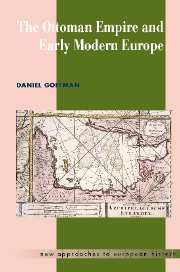Book contents
- Frontmatter
- Contents
- List of illustrations
- List of maps
- Preface
- Acknowledgements
- Note on usage
- Chronological table of events
- The Ottoman House through 1687
- 1 Introduction: Ottomancentrism and the West
- Part 1 State and society in the Ottoman world
- Part 2 The Ottoman Empire in the Mediterranean and European worlds
- Glossary
- Suggestions for further reading
- Index
- NEW APPROACHES TO EUROPEAN HISTORY
Preface
Published online by Cambridge University Press: 05 June 2012
- Frontmatter
- Contents
- List of illustrations
- List of maps
- Preface
- Acknowledgements
- Note on usage
- Chronological table of events
- The Ottoman House through 1687
- 1 Introduction: Ottomancentrism and the West
- Part 1 State and society in the Ottoman world
- Part 2 The Ottoman Empire in the Mediterranean and European worlds
- Glossary
- Suggestions for further reading
- Index
- NEW APPROACHES TO EUROPEAN HISTORY
Summary
The writing of Ottoman history has changed dramatically, for the better I believe, in the past few decades. In part, a widening access to Ottoman source materials in Istanbul, Ankara, Jerusalem, Cairo, and elsewhere has supplemented and in some cases supplanted the Ottoman chronicles and western European correspondences and observations that previously had constituted the documentary backbone of our knowledge of the empire. Increasing reliance upon the views of the Ottomans about themselves in place of often hostile outside observers has allowed us to better imagine an Ottoman world from the inside. In addition, a growing appreciation for non-European societies and civilizations and the generation of new historical and literary analytical techniques have helped us take advantage of this plethora of documentation, while enlivening and making more sophisticated the historiography of the early modern Ottoman world.
One goal of The Ottoman Empire and early modern Europe is to help move some of these innovative and stimulating approaches toward Ottoman history out of monographic and article form and make them accessible to a general and student audience. The result may seem a hybrid between the new and the old, for developments within the field have been uneven, many gaps remain in our knowledge, and some of our interpretations still are speculative or rest on publications and approaches that are terribly outdated. For example, whereas recent studies provide thought-provoking insight into elite Ottoman households, our knowledge of gender relations outside of the privileged order remains thin.
- Type
- Chapter
- Information
- The Ottoman Empire and Early Modern Europe , pp. xiii - xvPublisher: Cambridge University PressPrint publication year: 2002

